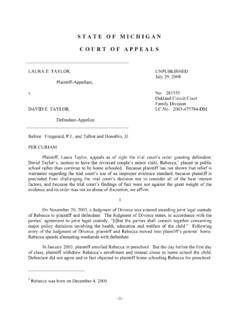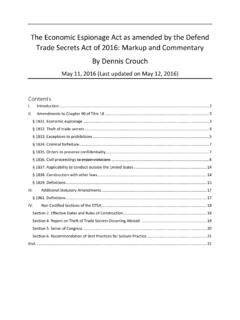Transcription of Trade Secret Law the Employment - michbar.org
1 20 Trade Secret Lawthe EmploymentBYCAREYDEWITTT rade Secret Lawthe Employment21 Trade Secret LAWJANUARY 2005 MICHIGAN BAR JOURNALH andling amisappropriation caseGiven the increasingly transitory nature of the employmentrelationship and the digitally portable quality of businessinformation, today s Employment lawyer must be awareof both employees and employers obligations under Trade secretlaw. Essentially, all counsel must be aware of the means to pre-vent and disprove misappropriation, and the employer s counselwill sometimes be called upon to file and support an action alleg-ing misappropriation. Aside from patent, trademark, and copy-right protection, there are two primary legal sources typicallyconsidered in litigation involving alleged misappropriation of anemployer s Trade secrets : (1) statutory Trade Secret law (the nowbroadly adopted Uniform Trade secrets Act); and (2) bilateralcontracts with employees.
2 This article will discuss both of thesesources and the related issues that arise in the event of Michigan Uniform Trade secrets Act (MUTSA) (a statute in often identi-cal form in place in many jurisdictions around the ) defines a Trade Secret as:Information, including a formula, pattern, compilation, program, device, method, tech-nique, or process, that is both of the following:(i) Derives independent economic value, actual or potential, from not being generallyknownto, and not being readily ascertainableby proper means by, other personswho can obtain economic value from its disclosure or use.(ii) Is the subject of efforts that are reasonable under the circumstances to maintainits courts have recognized customer lists and information, costs, internalweaknesses, marketing and strategic plans, diagrams, survey data, prices and sim-ilar information as satisfying these displaces any conf licting common law of Trade secrets , so that de-cisions heavily relied upon by practitioners in the past such as Hayes-Albion vKuberski3(describing a common law/Restatement definition of Trade secrets ,prohibited misappropriation, and available remedies), have been expressly pre-empted by the proof issues in litigating misappropriation of Trade Secret cases (andin non-compete cases, where a reasonable competitive business interest must beestablished)
3 Arise in establishing the confidential natureof the information to beprotected. Under the Uniform Trade secrets Act (and also under common lawcases on Trade secrets ), several confidentiality (secrecy) factors will be considered: the actual extent of measures taken by the employer to guard the secrecy ofthe informationforLawyerforLawyerHandling amisappropriation case22 MICHIGAN BAR JOURNAL JANUARY 2005 Trade Secret LAW the extent to which the information isknown by others in the same business the ease or difficulty with which the in-formation can be properly duplicated oracquired by othersReasonable steps to guard the confidenti-ality of information could include (althoughrelatively few employers employ all of thefollowing): storage of information with locked, lim-ited access need-to-know information access electronic key access to rooms/infor-mation clear marking of confidential infor-mation limited access of computer-stored infor-mation visitor restrictions, and other means ofavoiding unnecessary disclosures, suchas scrutiny of brochures and websites toprevent release of secrets employee policies on confidential infor-mation, or confidentiality, non-solicita-tion, (employee)
4 Anti-raiding, or non-compete agreements routine verification of confidentialityprocedures routine employee reminders of conf i-dentiality policy pursuit of departing employees with ac-cess to confidential information prohibiting removal of confidential in-formation from company premises restricting copying of confidential in-formation (numbering copies, etc.) conducting exit interviewsProving MisappropriationMUTSA essentially allows recovery or aninjunction for theft or other impropermeans by which a Trade Secret is statute also allows recovery against anentity that knew or should have known itwas acquiring a Trade Secret stolen by some-one EvidenceNot often is it the case that a former em-ployee is caught red-handed either takingconfidential information or disclosing it toothers (although this may sometimes beprovable with download histories from theemployee s work or home computer or thecompany s server or other records).
5 As such,entitlement to injunctive relief often relieson circumstantial proof. Such proof mayamount simply to laying out the obvious factsfairly, thus painting an inferential picture,such as the former employee s new work for ahead-to-head competitor selling similar/iden-tical products, customers, or courts have recognized the need forcircumstantial evidence under the doctrineof inevitable the lead case, Pep-siCo v Redmond,7the court entered an in-junction against a former employee who wasworking for a competitor even in the absenceof a non-compete where the executive wasinvolved in marketing and financial planningat both his former and new company. Thefact that he occupied a similar position at hisnew employer was significant to the court inthat the court found that Redmond couldnot compartmentalize his knowledge of in-formation and he could not help but rely onthat information.
6 The court concluded thatRedmond would inevitably disclose tradesecrets as prohibited under the Illinois Uni-form Trade secrets disclosure factors under Red-mond (not all are necessarily present in everycase) include: the employee s dishonesty as to his orher new employer or duties8 the plaintiff employer s ability to specifyits Trade secrets in court9 the new employer s opportunity and incentive to use the former employer sinformation similarities between the former positionand the new position, such that the de-parting employee will himself or herselfbe in position to use and/or disclose theconfidential information Memorized InformationAlthough there is old, and somewhatbizarre, case law to the contrary, the Uni-form Trade secrets Act does not make atrade Secret any less protectable because it has a full range of available rem-edies.
7 The Act allows for injunctions against actual or even threatened use (critical atthe preliminary injunction stage), mandatory(affirmative) injunctions to protect secrets ,imposition of royalty obligations, actual dam-ages, unjust enrichment damages, and at-torneys fees for willful or malicious misap-propriation or bad faith pursuit or defense ofa A ViableMeans of ProtectingTrade SecretsAlthough an employee agreement is not atall necessary to support a Trade Secret misap-propriation case (UTSA contains no such re-quirement and the courts have found no suchrequirement implied in the Act), Trade secretlaw is often connected with enforcement ofnon-compete, non-solicitation, and confi-dentiality agreements, in that: (1) Trade secretand non-compete violations often occur to-gether, and (2) Trade Secret protection is a rec-ognized basis for enforcing a states allow enforcement of non-competes under certain conditions, and sinceFast Facts:Fast Facts: MUTSA displaces any conflicting common law of Trade secrets , so thatdecisions heavily relied upon by practitioners in the past have been expresslypreempted by the statute.
8 MUTSA essentially allows recovery or an injunction for theft or other improper means by which a Trade Secret is acquired. Confidentiality/non-disclosure agreements have had judicial approval for quitesome time, having been considered an exception to Michigan s antitrust Secret LAWJANUARY 2005 MICHIGAN BAR JOURNAL1987 Michigan has permitted such restric-tive covenants in Employment a restrictive covenant is necessaryessentially depends upon the improper dam-age a former employee could do to the em-ployer after joining a competitor or relatedbusiness other than the mere fact of his orher competition. Thus, under the statute,such agreements are legitimately designed toprevent post- Employment unfair competi-tion by the departing agreements are generallyenforceable if they satisfy the four conditionsset forth in :a.
9 The agreement has a reasonable geo-graphic scope for example, the employer sservice area, the location of the employer sclients, or the employee s assigned territory orclients. In some circumstances, even a na-tionwide non-compete is The agreement has a reasonable dura-tion. This element will vary by industryand employee. For example, six months maybe appropriate in some circumstances, whileone year or much longer may be more ap-propriate in other The agreement is reasonable (sufficientlynarrow) as to the line of work it The agreement is designed to protect rea-sonable competitive business interests( Trade secrets or goodwill).The Importance of ConfidentialityMeasures in Non-Compete/Non-Solicit EnforcementA listing of possible confidentiality meas-ures for Trade secrets was provided supra inthe discussion of the Uniform Trade SecretsAct.
10 The reader is asked to employ thesemeasures to protect the secrets in questionand to lay the groundwork for any necessarylitigation to prove and enjoin misappropria-tion. While this list will not be repeated here,one point bears emphasis: It is often suchmeasures that make or break enforcement ofa non-compete, in that courts look to how aparty has cared for its protectable interest often Trade secrets to determine whetherirreparable harm is truly AgreementsConfidentiality/non-disclosure agreementshave had judicial approval for quite sometime, having been considered an exceptionto Michigan s antitrust laws. Unlike non-compete agreements, confidentiality/non-disclosure agreements generally will be en-forced without examination of their effect oncompetition. Nonetheless, observing the re-quirements of the Trade secrets Act (see su-pra) will make the confidentiality agreementboth more useful and likely to be enforcedby injunction.



















